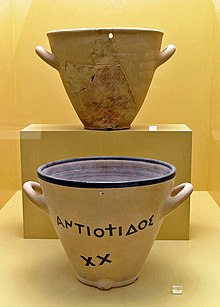Clepsydra
Klepsydra or Klepshydra (from ancient Greek κλεψύδρα klepsýdra , German 'water thief ' ) was the name of a water clock used in ancient Greece .
function
A Klepsydra consists of two containers. The water flows from the outlet container filled with water into an inlet container. The water level in the inlet tank shows the elapsed time . According to this principle it is like the hourglass ; Both clocks consist of two containers between which "particles" flow. This particle flow is related to the passage of time.
Later versions with gear drives connected with a float were also built. These are a precursor to the modern watch.
origin
Like the other important measuring instruments in ancient Greece ( Gnomon and Polos ) it comes from the Middle East .
use
In ancient Greece, klepsydrons were used not only to measure the hours in general, but especially to limit the speaking time of the contending parties in court. However, it has not found use in every type of process.
Designs
Antiquity
The Klepsydra could have different designs. Some were similar to a suction cup, a large pipette . This is a jug-like vessel that narrows towards the top. It has a larger opening on the upper side and many small holes on the underside. To draw water, the Klepsydra is immersed in the water, the top opening is closed and the instrument filled with water is lifted out of the water. In the belly of the vessel there is water that can be transported to any location.
With such a Klepsydra the Greek Anaxagoras proves the non-existence of empty space through simple experiments within the scope of his results, which is erroneous from today's point of view . In the first attempt the Klepsydra is pressed into the water with the upper opening closed so that no water can penetrate; in the second attempt the Klepsydra, which is filled with water and closed at the top, is carried outside the water. Anaxagoras interprets the first attempt as the pressure of a substance in the Klepsydra, which prevents the water from penetrating the vessel. In the second attempt, he blames the pressure of the material space outside the vessel for the failure of the water to escape from the Klepsydra. Such and similar attempts with the Klepsydra were popular with the pre-Socratics .
Moroccan Klepsydra
In the Moroccan Klepsydra, the smaller container floats in the larger one and has a small hole in the middle of the bottom. As soon as it sinks into the larger container, a defined period of time has passed.
Loan word
In the Polish language , the loan word klepsydra names not only a water clock but also an hourglass , but also an obituary or obituary notice .
Web links
- Water clock. In: Wondrous hodgepodge. January 22, 2003 (private website)
Individual evidence
- ^ Moritz Hermann Eduard Meier , Georg Friedrich Schömann : The Attic Proceß. Gebauersche Buchhandlung, Halle 1824, p. 713 f. ( Scan in google book search).
- ↑ سايهي شهرداري نجفآباد بر كهنترين «ساعت آبي» شهر. (No longer available online.) In: amordadnews.com. Archived from the original on April 29, 2014 ; Retrieved October 4, 2019 (Persian, 13/09/1390 i.e. ).
- ↑ Jochen Schmidt , Line Hoven: Schmythologie: Klepsydra. In: FAZ.net . Retrieved March 3, 2014 (Fig. 5/71).
- ^ Translations for the word "Klepsydra". In: pons.com. Retrieved March 3, 2014 .

